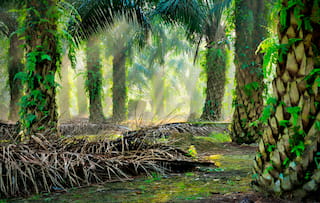Turning Europe’s good intentions into effective action to stop deforestation

It is said that the road to hell is paved with good intentions and the same is true when it comes to international efforts to halt deforestation. This week, the IPCC released its Sixth Assessment Report, once again highlighting the key role of forest protection in mitigating climate change and adapting to its impacts. Despite decades of such advice and well-meaning policy, we’re still losing our remaining forests at an alarming rate. Progress is slow on cutting ‘brown’ carbon emissions from fossil fuels, and efforts to protect the much larger quantities of ‘green’ carbon in our forests and soils are even slower. This failure is speeding our descent into extreme weather and depriving us of the richest systems of life on earth.
Consuming countries have lately moved to using trade policy to reduce the market pull for commodities linked to deforestation, like palm oil from Indonesia, beef and soybeans from Brazil or cocoa from West Africa. The biggest of these is the new EU policy on deforestation-free products, due to come into force in 2024, which aims ensure that countries or parts of countries that fall short of zero deforestation cannot export deforestation-linked products to Europe. It’s a big commitment which has been widely welcomed. The question is whether the EU’s boldness of intent can be turned into a durable mechanism that slows and stops deforestation.
The EU regulation is certainly going to shake up many existing trading relationships and supply chain models. For a start, it requires mass commodities like soy, which are currently mixed in origin, to be segregated for Europe and shipped separately. It’s also going to require every forest risk commodity producer – from the largest cattle farm to the smallest cocoa smallholder – to be identified by geolocation data.
Unfortunately, there are also some big risks, the gravest of which is the likelihood that if Europe ‘cleans’ its imports deforestation-risk commodities will be diverted to other parts of the world. For example, soy from US fields that were converted from forest or savannah centuries ago may be dedicated to European market whilst soy from the deforestation-risk Cerrado areas of Brazil or the Chaco of Paraguay is exported to Asia, were there are no sustainable import standards. The net result could be no slowing of aggregate deforestation and possibly an increase in forest loss in some regions as market demand for more sustainable supply falls. This is perhaps the reason why the European Commission’s own regulatory impact assessment suggests the regulation will only prevent deforestation of 700 square kilometers each year, a small fraction of the deforestation impact EU commodity imports are having globally.
IDH and Proforest have spent the last couple of months working up proposals which we think would address these risks if the European Council and Parliament want to address the root causes of deforestation and encourage forest positive investment from commodity buying companies.
There are two big steps that could be taken. The first is to classify those jurisdictions that have time-bound, speedy and credible plans to get zero-deforestation as ‘transitional risk’ and for European governments and consumer goods companies to offer support to achieve their goals. Jurisdictions, meaning the boundary of local or regional government with regulatory or planning powers over land use, can be instrumental in applying the regulation and aligning farming and conservation interests. Allowing these jurisdictions to transition to zero deforestation over a defined and short period also builds on the UN Guiding Principles on Business and Human Rights of encouraging continuous improvement. It engages producer governments with positive incentives and means that European demand can positively influence all production in each jurisdiction, not just those supplying EU consumers.
Secondly, we suggest that the information collection requirements should be varied depending on the level of risk of the country or jurisdiction – so they would be tougher for high risk locations, where we think farm data rather than point data would be more meaningful, and lower for low risk and transitional areas where jurisdictional information collection should be sufficient.
Taken together we think these steps could overcome the significant weaknesses of previous attempts to stop deforestation. They would provide a means to engage and reward forest rich countries and jurisdictions that are making progress, rather than handing down an absolute judgement from Europe based on whether they achieved zero deforestation by 2020 and creating further diplomatic friction between developing nations and the EU. They also build on the great track record of jurisdictions in Asia, Latin America and Africa that have demonstrated that when you align communities, regulatory authorities and purchasing companies on a plan to protect forest, improve production and improve livelihoods you really can tackle the root causes of deforestation.